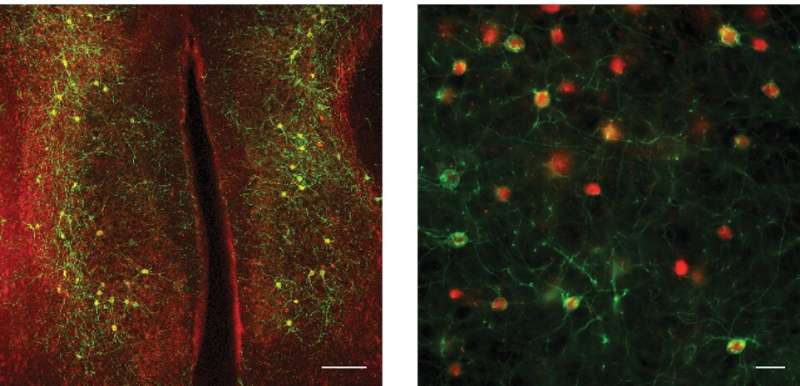Credit: Cho et al.
In order to survive and thrive, humans and other living organisms must continuously acquire new strategies to adapt their behavior to changing environments. Past studies suggest that the synchronization between different brain cells could create flexible brain states that facilitate behavioral adaptation to different situations.
Organisms have often been found to exhibit rhythmic neural activity that simultaneously occurs in different parts of the brain in a synchronized fashion. However, neuroscientists have not yet been able to determine whether this synchronized activity is important for specific brain functions or is merely a by-product of the way in which brain circuits are organized.
Interestingly, people with mental health disorders such as schizophrenia and autism have been found to exhibit deficits in synchrony between neurons. Understanding the meaning and significance of synchronized neural activity could thus have important implications for several fields of study, including neuroscience, psychology and psychiatry.
Researchers at the University of California, San Francisco, in collaboration with scientists at Harvard and Stanford University, have recently carried out a study exploring the role of gamma-frequency (~40 Hz) synchrony between prefrontal parvalbumin (PV) interneurons in mice that are acquiring new stimulus-reward associations. Their paper, published in Nature Neuroscience, offers new insight that could ultimately enhance our understanding of abnormalities in neural synchronization patterns observed in people affected by a number of mental health disorders.
"We currently do not understand whether deficits in synchrony associated with specific mental disorders need to be corrected in order to treat them," Vikaas Sohal, one of the researchers who carried out the study, told Medical Xpress. "In our recent study, we set out to evaluate whether this synchrony actually contributes to learning in mice."
In their study, Sohal and his colleagues used an approach known as optogenetics, which uses light-sensitive proteins that can activate neurons to control the synchrony between neurons in the left and right hemispheres of the brains of mice. This allowed them to test whether altering the synchrony of these neurons affected the mice's associative learning during conditioning experiments.
"We then used genetically encoded voltage indicators—proteins which change their fluorescence based on neuronal activity—to detect when specific neurons in the left and right hemisphere became synchronized," Sohal explained.
The researchers' experiments yielded a number of interesting results. First, when mice received information suggesting that some of their previously learned associations were no longer valid, Sohal and his colleagues observed significant cell-type-specific increases in the cross-hemispheric gamma synchrony between PV neurons.
When the researchers disrupted these synchronizations using optogenetics, the mice appeared to keep acting based on associations that they previously learned, without adapting their behavior to the situation at hand. However, this did not occur when they used in-phase stimulation or out-of-phase stimulation techniques at other frequencies.
"Essentially, we found that gamma frequency synchronization between a specific class of neurons located in the prefrontal cortex occur, and are necessary during specific kinds of learning," Sohal explained. "More specifically, synchronization is important when mice have to reappraise the behavioral significance of external cues, e.g., a cue that was previously present but irrelevant to task performance suddenly becomes important."
Sohal and his colleagues gathered valuable new insight about the role that cross-hemispheric gamma synchrony plays in the behavioral adaptation of mice as they learn to make new cue-reward associations. More specifically, they found that gamma synchrony is essential for re-evaluating the behavioral salience of external stimuli (i.e., how one can best adapt his/her behavior in response to certain cues in the surrounding environment).
In the future, this observation could pave the way for new studies investigating the impact of gamma synchrony on different types of learning. Combined, these works could ultimately enhance the present understanding of how this type of neural synchronization differs in people affected by certain mental health disorders.
"In our next studies, we would like to investigate how the cross-hemispheric gamma synchrony we unveiled is generated and how particular drugs can enhance it," Sohal said.
More information: Kathleen K. A. Cho et al. Cross-hemispheric gamma synchrony between prefrontal parvalbumin interneurons supports behavioral adaptation during rule shift learning, Nature Neuroscience (2020). DOI: 10.1038/s41593-020-0647-1
Journal information: Nature Neuroscience
© 2020 Science X Network
























